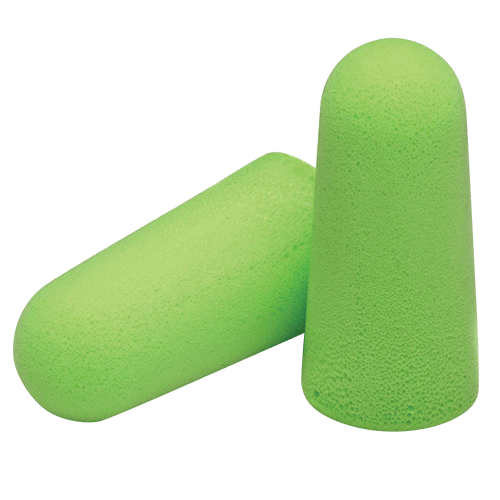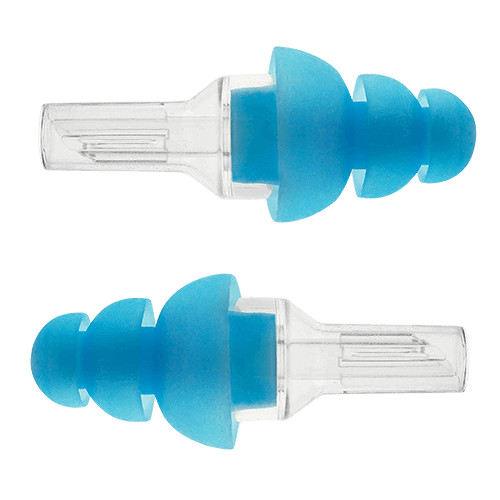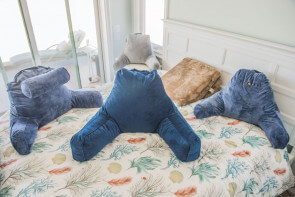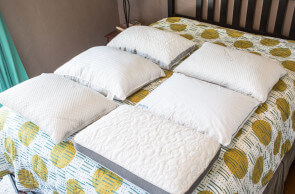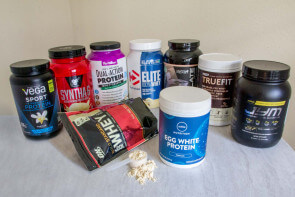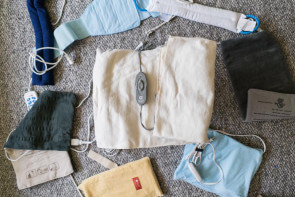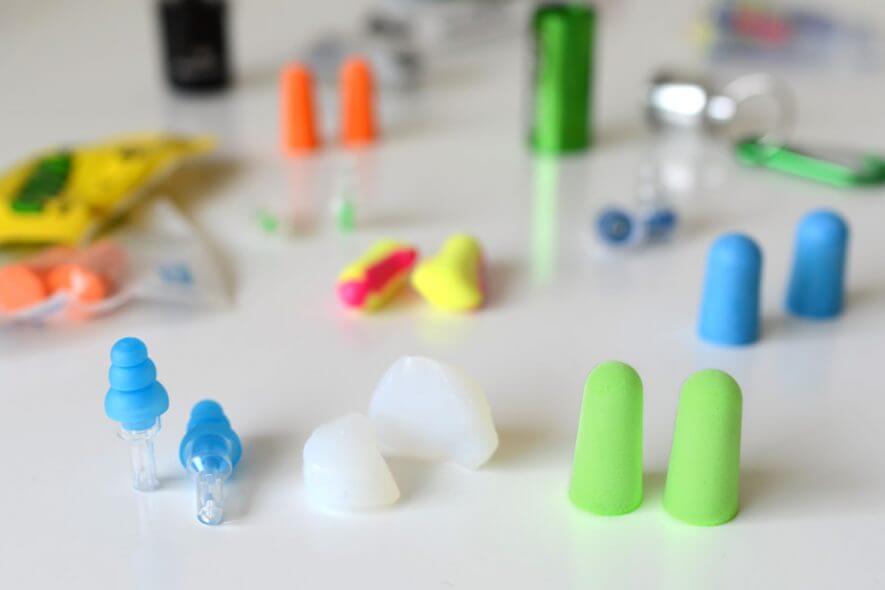
The Best Earplugs
Our collective experience as professional musicians, frequent travelers, and avid music fans who have worn countless earplugs over the years informed our tests and ratings to determine the best earplugs for the casual consumer. We tested the 12 top plugs on the market over the course of three weeks, putting each pair through a series of critical tests, and determined that Moldex – Pura-Fit are the best earplugs for noise blocking, Mack’s – Pillow Soft Silicone Putty are the best earplugs for sleeping, and Etymotic Research – ETY-Plugs are the best for critical listening.
Our collective experience as professional musicians, frequent travelers, and avid music fans who have worn countless earplugs over the years informed our tests and ratings to determine the best earplugs for the casual consumer. We tested the 12 top plugs on the market over the course of three weeks, putting each pair through a series of critical tests, and determined that Moldex – Pura-Fit are the best earplugs for noise blocking, Mack’s – Pillow Soft Silicone Putty are the best earplugs for sleeping, and Etymotic Research – ETY-Plugs are the best for critical listening.
Table of contents
- The 12 earplugs we tested
- 1. Best for noise blocking: Moldex – Pura-Fit
- 2. Best for sleeping: Mack’s – Silicone Putty
- 3. Best for critical listening: Etymotic Research – ETY-Plugs
- Others products we tested
- How we selected
- How we tested
- Types of earplugs
- The bottom line
The 12 earplugs we tested
| Product | Price | Plug Style | Comfort | Noise Blocking |
|---|---|---|---|---|
| 1. Moldex - Pura-Fit 6800 | $ | Memory Foam | 3/5 | 5/5 |
| 2. Mack's - Silicone Putty | $ | Putty | 5/5 | 3.5/5 |
| 3. Etymotic Research - ETY Plugs | $$$ | Flanges | 4.5/5 | 2/5 |
| 4. Soundtight (now Mixerfy) | $$$ | Flanges | 4/5 | 2/5 |
| 5. LiveMus!c - HearSafe | $$$$ | Flanges | 4.5/5 | 2/5 |
| 6. Pro Vibes | $$$ | Flanges | 4.5/5 | 1.5/5 |
| 7. Surefire - EP4 Sonic Defenders Plus | $$$ | Flanges | 4/5 | 3/5 |
| 8. Eargasm - Hi Fidelity Earplugs | $$$$ | Flanges | 3/5 | 1/5 |
| 9. Hearos - Xtreme Protection | $ | Memory Foam | 3/5 | 4/5 |
| 10. Mack's - Ultra Soft Foam | $ | Memory Foam | 4/5 | 3.5/5 |
| 11. Howard Leight - Laser Lite | $ | Memory Foam | 2.5/5 | 4/5 |
| 12. DuraPlugs - 14310 | $ | Memory Foam | 2.5/5 | 3.5/5 |
1. Best for noise blocking: Moldex
If silence and isolation from the loud world around you is your thing, Moldex – Pura-Fit is your earplug. These scored the highest in our environmental noise test, even outperforming other plugs with higher NRR ratings. They are not the largest nor the densest plugs out of the foam plugs, yet we found them to block the most sound.
They are tied with Duraplugs for being the longest in length, though they are slightly thicker. To the naked eye, we don’t see much of a difference in material besides color. Up close, its tiny foam pores look about the same size as those in the other foam plugs. Hearos Xtreme Protection plugs are rated the highest at 33 dB NRR — beating out the Pura-Fits by 1 dB — and are markedly thicker than the Pura-Fits; however, they simply don’t block out as much sound.
Like all the other foam earplugs, these are disposable. You can use them until they collect too much dirt, wax, or debris at your own discretion. Good thing, because our order came in a large cardboard box with one hundred individually wrapped pairs which could potentially last you a lifetime. For extra credit, Moldex was the only company to package their individual pairs in paper instead of plastic, a big plus in our book.
In a pinch, foam earplugs will work for loud concert or music listening settings. Often times, bars will keep a large box of individually wrapped earplugs for sale for a buck or two. Cheap foam plugs will protect you from high volumes even better than flanged plugs because they have higher NRR ratings. We unequivocally recommend them (at the cost of audio quality) if you don’t have flanged plugs on hand.
These will also work well for sleeping, though they were not our number one choice. Because foam plugs are so inexpensive and also work well for sleeping and general hearing protection, we recommend them most for general usage. Easily replaceable and cheap, they are in some ways the most user-friendly and versatile.
2. Best for sleeping: Mack’s – Silicone Putty
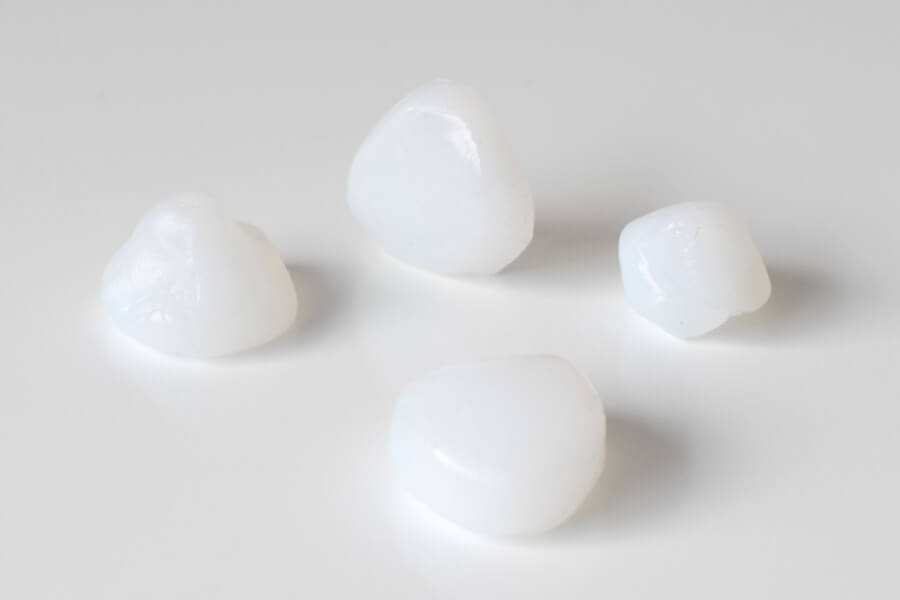
For extended comfort and a custom fit when sleeping, our favorite choice was Mack’s – Pillow Soft Silicone Putty. For this purpose, the oldest technology wins out over plastics and sophisticated filter technologies. Application can be a bit fussy at first, but the comfort of not having something inside your ear canal outweighs the convenience of the other kinds. Flanged earplugs were almost as comfortable, except most of them had stems that pushed against the plugs when sleeping on your side.
If balling up putty isn’t your thing, the most comfortable flanged plug in this category were the Eargasms, with no stem at all. Please note that the Eargasms are significantly larger than the other flanged plugs, so they may not be the best fit for smaller ears.
After the many hours of testing earplugs, our ear canals started feeling a bit sore. The putty style was a welcome change, and in our opinion fares best for longterm wear. The sense of pressure or suction is a lot less severe with putty than foam.
Since the fit is customizable, you can easily loosen or tighten as you see fit. The key is to get a good seal, by stretching it outwards against the curves of your ears. You can flatten the putty against the ear so that nothing juts out and pushes the plug beyond where you want it.
Mack’s warns that misuse may lead to pieces becoming lodged in your ear. If you follow the instructions, this shouldn’t happen but we have noted it as a potential issue.
Mack’s Pillow Soft will last until they are “soiled or no longer sticky”, up to five uses. If you use a case for your foam plugs, they may last longer than the moldable type. The costs per pair of foam versus moldable types are negligible, so you can potentially get a slightly better value with foam plugs, depending on how clean you keep them.
In cases where sound blockage takes priority over comfort, defer to our pick for noise blocking, the Pura-Fit plugs. Pura-Fits rated average for comfort compared to our other finalists but provide the best sound blockage overall. At just under one dollar a pair for both Mack’s Pillow Soft and Pura-Fit plugs, we recommend trying both to see which is more comfortable for you.
3. Best for critical listening – Etymotic Research
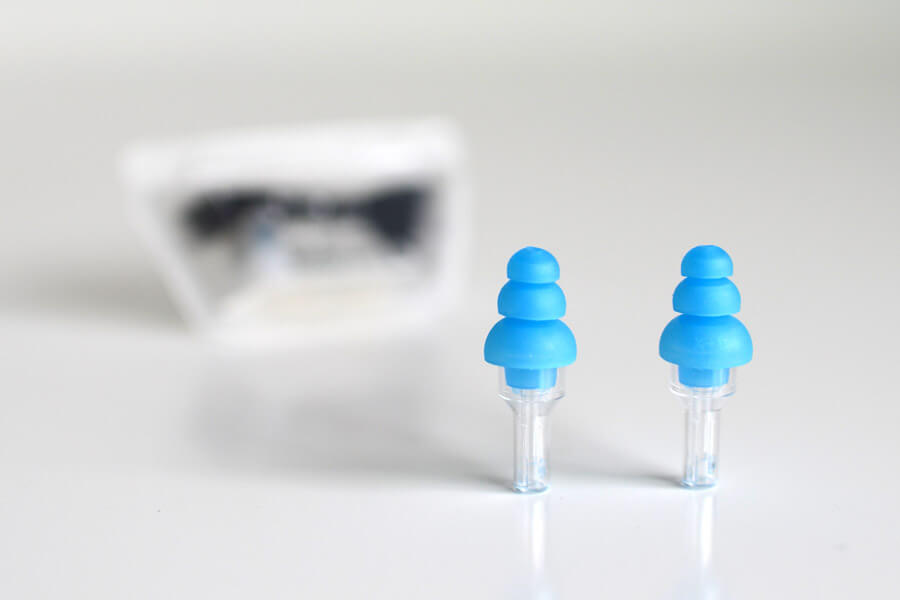
We had a points tie between Etymotic Research – ETY-Plugs (NRR 12 dB) and Soundtight plugs (NRR n/a), but since Soundtight plugs don’t have an NRR and cost about six dollars more, ETY wins as our first choice. Not only are the ETY plugs the most comfortable flanged earplug, they also sound the best to our ears. A reputable custom earphone company, Etymotic may have a leg up when it comes to hi-fi listening.
Best for Listening: Etymotic Research - ETY-Plugs
Marketed as a 'volume knob' for you ear, the ETY-Plugs provide better sound quality at mid and high frequencies, without the muffling effect induced by foam-style plugs. The ETY's cost more, but if sound quality is important, these are the plugs to go with.
What puts these two at the top for sound quality is the presence of more mids and highs. With foam plugs, you will find boomy low end while mids and highs frequencies (like talking) sound muffled. Without the higher frequencies to balance the lows, the result is a sound that is stuffy and far from natural. Etymotic plugs boast that they are like a “volume knob,” decreasing the level of sound in a more natural-sounding way.
In general, we found that plugs with lower NRR dB ratings sound better than those with higher ratings because they do less work. Our best performer, ETY plugs, block a relatively low 12 dBs versus heavy-duty foam plugs such as Howard Leight and Mack’s Ultra Soft Foam which block 32 dBs. Across the board, we found that higher dB reduction ratings came at a cost of lesser sound quality.
There is little documentation on filters used in the flanged type, so there is not much we can say about how they differ from one another, other than what we can hear and observe with the naked eye. Interestingly, the Soundtight earplugs sounded superior to the ProVibe earplugs despite looking almost identical.
Clearly, not all earplugs are created equally. Like the foam earplugs, size and fit can affect how well they will work for you. If the plugs are not far enough in your ear because they are too big, you may get a more pronounced occlusion effect — amplification of bodily sounds due to the blockage sound that would normally exit through the ear cavity.
Other products we tested

SoundTight
As mentioned above, the SoundTight’s flanged earplugs scored high in sound quality, but we were unable to find their NRR rating. They’ve been discontinued under this branding since our initial review and were re-launched as Mixerfy MX. They come with a handy, compact aluminum keychain carrying case, like a lot of the other flanged plugs, but arrived in a plain plastic bag with no formal packaging. To be fair, we have purchased other types of products this way, but for the price we paid for SoundTight, we expected more. Lacking NRR and country of manufacture, they didn’t exactly inspire confidence in consideration of serious hearing protection.
Duraplugs
Duraplugs are the “supermodels” of the bunch, the thinnest and tallest. As such, they may provide a better fit for those with smaller ears. The foam material also seems slightly more dense, with smaller visible “pores” (which helps our supermodel metaphor). They performed quite well in our noise-blocking test, but its denser material feels stiffer to the touch and therefore just slightly less comfortable.
Hearos Xtreme Protection
If Duraplugs are the supermodels of the bunch, Hearos Xtreme Protection are the dwarves of the earplug realm. They are shorter and wider than all the other plugs. However, they are the softest to the touch, which makes them slightly more comfortable than the Duraplugs or the Laser Lites, despite their size. They also scored very well for noise-blocking, which could make them a very good choice for those with bigger ears.
Howard Leight Laser Lite
Joining the motley crew of supermodels and dwarves are the Howard Leight Laser Lite plugs: the psychedelic bell-bottomed hippie of the bunch. In flamboyant pink and yellow, these guys stand out. They flare out like bell-bottoms, shaped like a rocket ship. Despite being the second softest, they don’t necessarily feel more comfortable. The flared design doesn’t help, as you have to compress more material at the bottom in order to achieve a deep fit. In terms of width, they are somewhere near the middle, so they may not be the first choice for small ears.
Mack’s Ultra Soft Foam
Let’s stop it with the metaphors. (But if we had to, Mack’s Ultra Soft Foam would be the very vanilla, average 9-to-5 Joe.) If you’re looking for the most comfortable foam plug, these are your guys. (The metaphor still works.) They don’t shine in any other category, but they will get the job done.
Eargasm Hi-Fidelity Ear Plugs
On the upper end of price, the Eargasms scored pretty high for sound clarity but not any more than other flanged plugs that cost less. We didn’t get close to anything that we would describe as an “eargasm;” however, they were the best flanged plug to sleep with for the lack of a stem in their design. In place of the stem is a small tab on the bottom flange used for removal. They run larger in diameter than the other flanged plugs, so we don’t recommend them for smaller ears. Like all the other flanged plugs, they also come with a convenient keychain carrying case.
LiveMus!c HearSafe
LiveMus!c HearSafe plugs would be our next pick after ETY plugs for critical listening. Despite being rated as blocking 17 dBs more than the ETY plugs, we couldn’t tell the difference. If you are looking for higher noise reduction for hi-fi listening, you might want to try these. (They are rated 29dB versus ETY’s 12dB.)
Surefire EP4 Sonic Defenders
Surefire EP4 Sonic Defenders are in a league of their own, as they are designed with military and tactical shooting in mind. They have an extra rubberized attachment which hugs the curves of the outer ear, creating a very secure fit. While designed and marketed towards hunters, shooters and the military, these will also work great for blocking general noise and nuisance and would especially excel in active situations requiring a secure fit. We wouldn’t recommend these for sleeping, as the extra stuff will definitely impede your comfort lying down.
Pro Vibes
Since our review, Pro Vibes was rebranded as Reverbs and comes to the party looking like the number one choice for millennials. They’re attractive, minimal and the most current out of the bunch. However, despite looking identical to the SoundTights, the green filter Pro Vibes simply didn’t sound as good, as noted before. They sounded hollow, as if we were listening through a tin can. The old adage “don’t judge a book by its cover” couldn’t ring any truer when comparing the two. Skip the fancy packaging and go with ETY flanged plugs for superior sound.
How we selected

With so many brands to choose from and with so many looking so similar, it was daunting to know where to start. During our research, we got a better picture of which earplugs sold the most and which garnered the best reviews. From there, we gleaned a list of finalists representing the best of each type available. Aiming at the casual to “prosumer” level user, we kept our ceiling at $30 per pair.
Researching crowd-sourced reviews and popularity ratings from retail stores helped inform our list as well. Many resources available online about earplugs and hearing protection come from stores and brands that sell earplugs. The first few links from a web search for “hearing protection” are of Home Depot, Cabela’s, Grainger, Dick’s Sporting Goods and 3M. We gained insight into which types and brands are more common in each market: home improvement, sporting goods, manufacturing, hunting and music.
From our digging, we learned what was important to different users for different purposes. For example, you wouldn’t use the same earplugs for a concert as you would earplugs for sleeping. Combined with our personal experience and years of using earplugs, we determined our criteria for testing and developed methods for each field.
How we tested
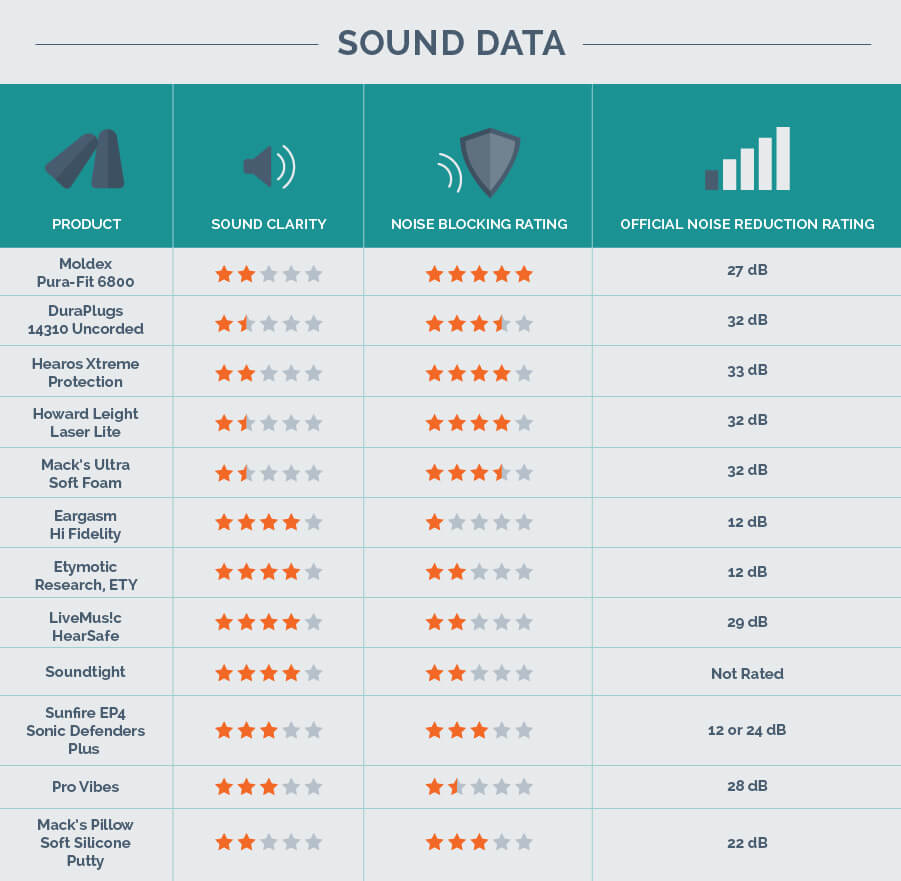
We put our top picks through a series of tests for wear comfort, sleep comfort, sound clarity, environmental nuisance, fit, and included an objective soundbox to test against claimed Noise Reduction Ratings.
Wear comfort test
To test wear comfort, we wore each pair of plugs for an hour. Our testing spanned a few days in order to avoid fatigue from having an impact on subsequent tests. Foam earplugs across the board were very comfortable initially, but ratings slipped after about twenty minutes of wear. The pressure created by sealing off air in the ear canal contributed to this discomfort, along with a pronounced occlusion effect.
Very slight disorientation occurs when worn for long periods of time; we began feeling disconnected from the space around us, feeling an intense “internal” sensation as the sound of our heartbeat and breathing heightened.
Higher-end frequencies are blocked more significantly than lower frequencies, so the overall effect is muffled and boomy, which in itself creates a nuisance of its own. Nevertheless, out of the five foam plugs, our favorite for comfort by a small margin was Mack’s Ultra Soft Foam. They are more tapered than Leight Laser-Lites and Pura-Fits, and more porous than the DuraPlugs, resulting in a slightly more comfortable fit.

Of the flanged plugs, ETY plugs edged out LiveMus!c and Pro Vibes due to a very subtle difference — the slight texture of the silicone flanges aided in smoother insertion. The smooth clear silicone of the Eargasms, for example, gave a little resistance. Overall, this difference is very subtle — it’s not a dealbreaker.
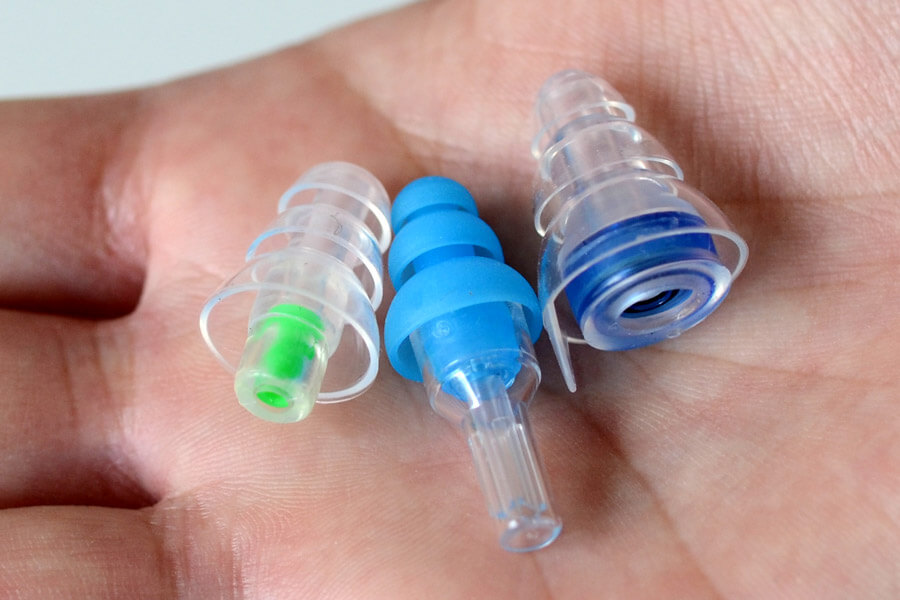
The flanged plugs were generally more comfortable than foam plugs, but Mack’s Pillow Soft Silicone Earplugs were the most comfortable earplugs overall in our testing.
Sound clarity: Music listening test
We tested sound quality by wearing each pair and listening to music from speakers and listening to live music during band rehearsal.
Using Tame Impala’s song “Let It Happen” playing through Sonos Play:5 speakers, we wore each pair for the duration of the song in quick succession in order to rate in relation to one another.
Some repeat listens were required in order to make the call. We listened for sound quality closest to that without plugs. For the live band rehearsal test, we wore each pair during rehearsal for the same set of three songs. We then took the ratings for the sub-categories and averaged them for the overall score in this category.
The flanged plugs unsurprisingly out-performed the foam and putty earplugs, with these four tied at the top: Eargasm, Etymotic, LiveMus!c and Soundtight.
Sleep comfort: Pillow test
To measure comfort during rest or sleep, we developed our own “pillow test.” We put each pair under fifteen minutes of scrutiny in different positions lying down: left side, right side, and back. Ear canals change in size and shape when the head tilts back, forth, and side to side, so it is important to test earplugs as you move around, as you would during sleep.
Theoretically, foam plugs should have an advantage since they are pliable. However, we found that flanged earplugs were just as pliable and movements were quieter due to a lesser occlusion effect. To get a complete score for the best earplugs for sleeping, we compounded this score with the wear comfort and noise blocking score.
Noise blocking test
In Los Angeles, the sound of the freeway is like the creek running behind your house. It’s a familiar fixture, a cultural symbol as sure as the moon and sun. As poetic as we can get here, it might just be the nuisance that keeps you from sleeping at night. You can feel freeway noise in the air, the higher frequencies like ambient white noise — just not as pleasant as say, the ocean.
In the US, the Federal Highway Administration recognizes the effects of freeway noise on public’s well being. They have regulations in place to limit the sound levels of commercial transport trucks and restrictions on certain roads to minimize exposure at certain times in the day. City planners take road noise into account when they plan roads and freeways, employing landscape features to lessen sound, for example.
For our noise-blocking test, we got comfortable with our earplugs on a footbridge above the 2 Freeway in Los Angeles and in a car parked next to a Del Taco under construction. We then rated each pair at both sites for how well they blocked out any and all sound. We averaged the two scores to get their total score in this category.
In contrast to our critical listening test, this test simply tested how well the plugs blocked out any sound regardless of listening quality. This grading is particularly useful for users to block any sort of audio nuisance: sleepers, students, teachers, travelers, anyone looking for peace in noisy environments. We all just want a little peace and quiet in the concrete jungle.
Fit

It’s all about fit. We found that fit is the second most important variable to consider when shopping for earplugs. You may need to buy a few pairs in order to test out before deciding which ones work the best for you. Because ear canal size can differ greatly from one person to the next, we realize that fit and comfort ratings may vary to a degree, as subjective as they are.
Noise Reduction Ratings are adjusted to account for the margin of error of users wearing earplugs incorrectly. Ill-fitting plugs may account for discomfort and incorrect usage, so we recommend that you shop the pair that feels most comfortable to you.
es and accessories. Even the government-mandated noise reduction ratings are not a failsafe way to judge effectiveness. After putting our shortlist through exhaustive testing, we determined that it was most useful to divide the ‘best of’ categories by usage: noise blocking, sleeping, and critical listening.
Types of earplugs
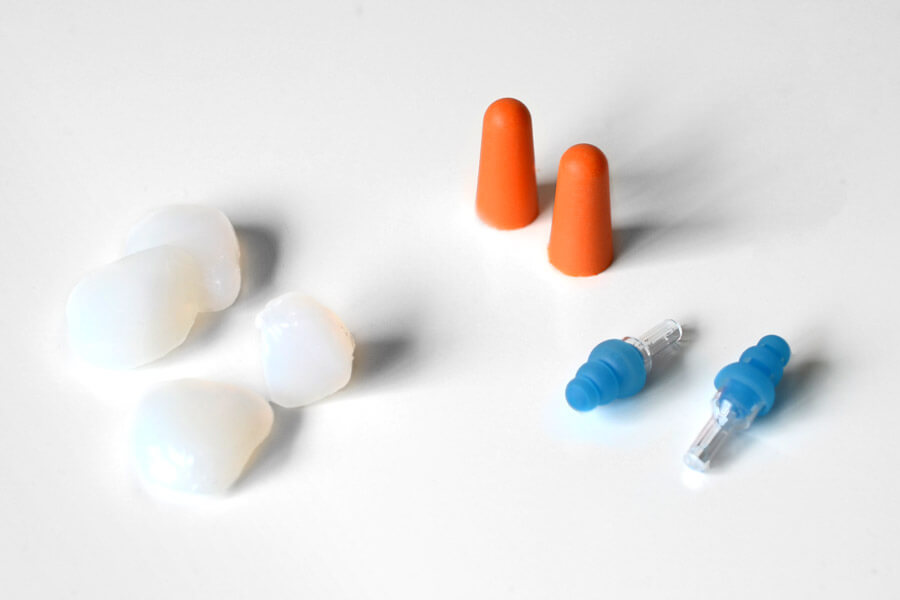
There are three main types of disposable earplugs: foam, flanged, and moldable. Each type has a fundamental design and function, but show variances in shape, color, design and material. Here we’ll break down each type and explain their differences.
Foam plugs
These are the most inexpensive and ubiquitous type, ranging anywhere in price from 10 to 90 cents per pair, sometimes packaged in bulk sets of up to two hundred pairs. Foam plugs offer very blunt, indiscriminate sound blockage, which makes them great for sleeping and blocking environmental nuisance.
Most foam earplugs available today are made of memory foam, inserted into your ear with the roll method: Twist them like you would wring a towel so that the plug is compressed into a tube, then insert into your ear and hold in place until it feels fully expanded.
We find this feeling a bit uncomfortable as the foam creates slight pressure as it pushes the air in your ear. When fully expanded, it blocks out external sound but also amplifies sounds in your body, like your heartbeat and breathing. This is known as the occlusion effect, wherein sound vibrating in the bone and cartilage that would normally exit through your ear canal is blocked.
Flanged plugs
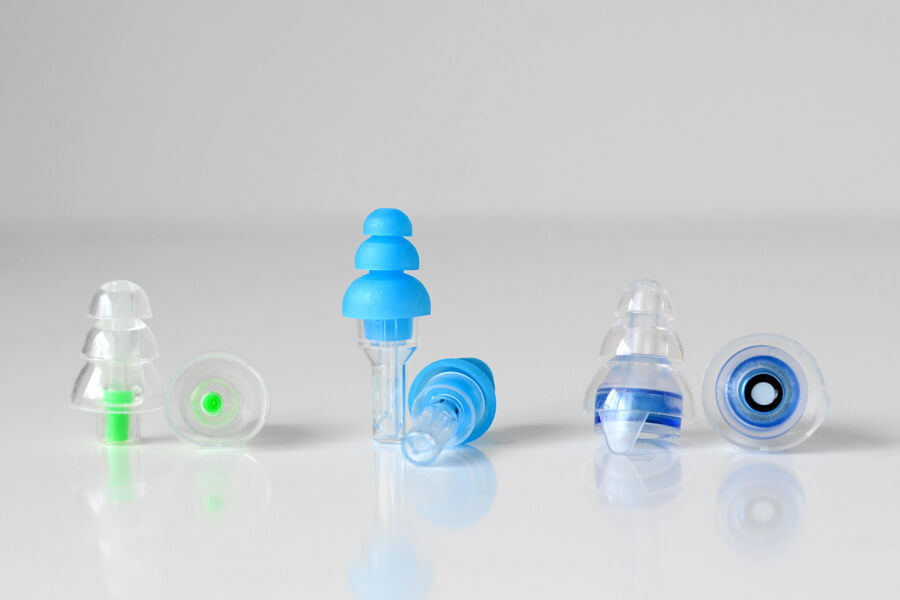
Flanged plugs are great when you want noise reduction without muffling when you need to listen to speech, details in sound, or music. Foam plugs cause incoming sound to be muffled, quiet, and therefore less intelligible.
Flanged earplugs are the next step up in price, quality, durability, and sound fidelity. Where foam earplugs will only last a handful of times, flanged earplugs will last anywhere between one and six months. Because they are cleanable, reusable for a longer period of time, and have much better sound quality than foam, there’s a significant leap in price to $20+ per pair.
Made of silicone and plastic, flanged plugs look like tiny futuristic Christmas trees. They are easier to wear and offer immediate protection once positioned correctly, without an expansion period like the memory foam plugs. At first glance, differences between brands are very small, however, our sound tests revealed some surprising results.
Flanged earplugs were designed with listenability in mind. All of our flanged finalists use a filter inside the stem that can provide different levels of Noise Reduction Ratings. Some brands claim to have designed these filters to let frequency ranges of the human voice pass through for tactical purposes, like Surefire’s Sonic Defenders.
Moldable Ear Plugs

Moldable earplugs were the first type to be available on the market. In 1907, Max Wegner of German-based company Ohropax originally sold a version made of beeswax. It wasn’t until 1962 that Ray and Cecilia Benner of Mack’s invented their own made of pure silicone putty, a waterproof material resistant to melting under heat. In our review of the best earplugs for sleeping, we recommend Mack’s as our top pick.
Disposable moldable earplugs typically come in individual pieces packaged in a protective plastic case. To use, shape a piece into a ball and push to fill the outer ear around the canal. Most popularly known for use while sleeping (for blocking out city noise and snoring), these earplugs also work well for preventing water from entering swimmer’s ears.
Noise reduction ratings

Earplug ratings are regulated by international standards and ratings. In the United States, the EPA requires that every product post their NRR (Noise Reduction Rating). This measures the potential of reduction in sound by dB (decibels).
These ratings rely on proper usage, which varies so greatly that OSHA (Occupational Safety and Health Administration) and NIOSH (National Institute for Occupational Safety and Health) developed derating systems to more accurately portray NRR.
In other words, earplugs are so often misused that an NRR may inaccurately portray the level of protection. As a consumer, it is difficult to know whether or not you’re wearing them correctly and even more so to tell the difference between correctly and incorrectly worn earplugs.
The bottom line

The earplug game is competitive and rife with innocuous features and accessories. Even the government-mandated noise reduction ratings are not a failsafe way to judge effectiveness. After putting our shortlist through exhaustive testing, we determined that it was most useful to divide the ‘best of’ categories by usage: noise blocking, sleeping, and critical listening.
The best noise-blockers, Moldex Pura-Fit foam plug show us how a simple design and concept can vary in results. Our top choice for use while sleeping, Mack’s Pillow Soft Silicone Putty, proved how and why they have stayed in the market for so long, making only minor changes in packaging over the years.
For critical listening, the flanged-earplug market seems awash with many different options that on the surface look almost identical to each other. However, our extensive testing shows that not all are created equally. While flanged plugs easily beat all-foam plugs for sound quality, ETY Plugs edged out on top by just a small margin. And if you’re looking for another way to block sound while you sleep, check out our review of the best white noise machine.
More Reviews
The Best Ear Plugs for Sleeping
Mack's - Pillow Soft
Baloo - Weighted Blanket
The 7 Best Pillows for Neck Pain
Coop Home Goods
Your Zone Bed
Linenspa
HOFISH - Gel Infused Memory Foam
Nest Bedding - Easy Breather
Bucky - 40 Blinks
The 7 Best White Noise Machines
ASTI - 'LectroFan
The Best-Tasting Protein Powders
Optimum Nutrition
Thermophore - MaxHEAT
HeathYoga - Eco Friendly Non Slip


